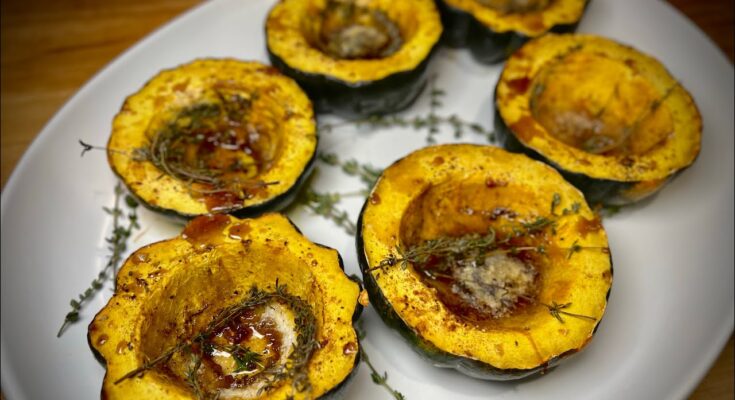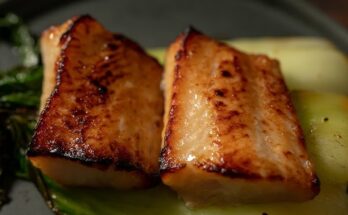Roasted Acorn Squash Recipe: There’s something magical about the cozy, caramelized flavors that come out of your oven in the fall. Roasted acorn squash is one of those comforting dishes that scream autumn. With its naturally sweet and nutty flavor, acorn squash is a go-to choice for home cooks looking to make something easy, nutritious, and seasonally appropriate. Whether you’re prepping for a holiday dinner or just craving a hearty vegetable side, this dish always delivers.
Acorn squash, when roasted properly, becomes buttery, tender, and slightly crisp around the edges—making it incredibly satisfying. Its vibrant yellow-orange flesh is not just a visual treat but a nutrition-packed addition to your meal. And let’s be honest—cutting into a roasted squash and watching it steam with aromatic spices and a hint of sweetness is the definition of fall comfort food.
But here’s the best part: it’s ridiculously simple. You don’t need to be a professional chef to nail this recipe. All you need is a sharp knife, a baking sheet, a few pantry staples, and about an hour of your time. Whether you’re new to cooking or a seasoned pro, roasted acorn squash should be in your autumn rotation.
Nutritional Benefits of Acorn Squash
Besides its comforting taste, roasted acorn squash is a powerhouse of nutrition. Each serving is rich in dietary fiber, which supports digestion and helps keep you full. It’s also packed with vitamins, particularly vitamin C, which supports immunity, and vitamin A (in the form of beta-carotene), which is great for eye and skin health.
Need more reasons to love it? Acorn squash is low in calories and fat, yet high in antioxidants and complex carbohydrates. That makes it perfect for anyone following a plant-based diet or simply trying to eat healthier. It’s naturally gluten-free and can be adapted for paleo, vegan, and vegetarian lifestyles. When paired with healthy fats like olive oil and seasonings like cinnamon or thyme, it becomes a guilt-free indulgence you’ll crave week after week.
What You’ll Love About This Recipe
- It’s quick and easy: With minimal prep and only a handful of ingredients, you can roast a squash even on a busy weeknight.
- Versatile flavor options: Whether you want sweet, savory, spicy, or herby, this dish adapts to your cravings.
- Meal prep friendly: Make it ahead of time and enjoy leftovers for lunch or dinner.
- Kid-approved: The naturally sweet taste makes it a hit with picky eaters.
- Budget-friendly: Acorn squash is one of the most affordable seasonal veggies at your local grocery or farmer’s market.
Ingredients You’ll Need
Basic Ingredients for Roasted Acorn Squash
Here’s what you’ll need for a simple, classic roasted acorn squash:
- 1 large acorn squash (or two small ones)
- 2–3 tablespoons olive oil (or melted butter for richer flavor)
- 1 teaspoon salt
- ½ teaspoon black pepper
- 1 tablespoon brown sugar or maple syrup (optional, for sweetness)
These ingredients create a beautiful balance of savory and sweet, with crispy edges and soft, melt-in-your-mouth flesh. The olive oil helps with caramelization, the salt enhances the squash’s natural flavor, and a touch of sugar or syrup brings out its sweetness.
Optional Add-Ins for Enhanced Flavor
Looking to level up your roasted squash? Here are some amazing additions:
- Cinnamon or nutmeg – for a warm, spiced flavor
- Thyme or rosemary – for a savory, herbal twist
- Garlic powder or minced garlic – to boost umami
- Chili flakes or cayenne pepper – if you like it spicy
- Parmesan cheese – sprinkled after baking for a salty crunch
- Butter glaze with brown sugar and pecans – for a dessert-like version
Mix and match depending on whether you’re serving this as a side dish, main course, or festive treat.
Ingredient Substitutions & Tips
- Olive oil: Swap with avocado oil, ghee, or melted coconut oil.
- Maple syrup: Honey or agave syrup works just as well.
- Brown sugar: Coconut sugar is a great alternative if you’re avoiding refined sugar.
- Acorn squash: Can’t find it? Use butternut or delicata squash as a substitute.
Pro Tip: Always taste-test your squash before roasting. Some can be a little more bitter than others, and adjusting sweetness or saltiness can help balance it out beautifully.
Equipment Needed
Kitchen Tools Checklist
To roast acorn squash properly, you’ll need just a few kitchen essentials:
- A large, sharp chef’s knife: for cutting the squash cleanly
- A sturdy cutting board: non-slip is best for safety
- Spoon or melon baller: for scooping out seeds
- Baking sheet or roasting pan: lined with parchment or foil
- Mixing bowl (optional): for tossing slices in oil and spices
- Oven mitts: safety first!
No fancy gadgets required—just solid tools that you likely already have at home.
Choosing the Right Baking Dish
You can roast your acorn squash directly on a rimmed baking sheet or inside a glass or ceramic roasting dish. Each option has its perks:
- Baking Sheet: Ideal for getting that crispy caramelization. Perfect if you want browned edges and a slight crunch.
- Roasting Dish: Better for retaining moisture and cooking with toppings like melted cheese or syrup glazes.
Either way, make sure to use parchment paper or foil for easy cleanup and to prevent sticking.
How to Prepare Acorn Squash for Roasting
Selecting the Perfect Acorn Squash
When choosing acorn squash at the store or market, look for the following signs of quality:
- Dark green skin with a little orange blush is ideal.
- Firm texture with no soft spots or blemishes.
- Heavier feel for its size—this usually means it’s denser and more flavorful.
- Matte finish instead of shiny, which can mean it’s more mature and sweeter.
Avoid squash with too many orange patches or extremely hard skin—those may be overripe or dried out inside.
How to Cut and Clean Acorn Squash Safely
Cutting squash can be intimidating, but here’s how to do it safely:
- Stabilize the squash: Lay it on a cutting board with a damp towel underneath to prevent slipping.
- Slice off the stem and base: This gives you flat surfaces to work with.
- Cut it in half lengthwise: Use a heavy knife and gentle rocking motion. Don’t rush—slow and steady wins the race.
- Scoop out the seeds and strings: Use a spoon or melon baller. Set the seeds aside if you want to roast them later!
- Slice into half-moons or quarters: Depending on how you plan to serve it—thicker slices are great for hearty sides, while thin ones cook faster.
You can also roast the squash halves face-down for a softer, more spoonable texture—great for stuffing or mashing.
Step-by-Step Guide to Roasting Acorn Squash
Step 1: Preheat and Prep
Begin by preheating your oven to 400°F (200°C). While it heats, wash the acorn squash thoroughly. Slice it in half from top to bottom, then scoop out the seeds and stringy bits with a spoon. You can save the seeds for roasting later if you like! Place the squash halves cut-side up on a baking sheet lined with parchment paper or foil.
Step 2: Seasoning the Squash
Brush the inside of each half generously with olive oil or melted butter. Sprinkle with salt and pepper for a classic flavor, or get creative with a drizzle of maple syrup, honey, brown sugar, or a pinch of cinnamon for a sweet twist. For a savory version, try garlic powder, thyme, or rosemary. The seasoning choice is your signature touch.
Step 3: Baking to Perfection
Roast the squash in the preheated oven for 40–50 minutes, depending on size. It’s done when the flesh is tender and caramelized at the edges — you should be able to easily pierce it with a fork. The aroma alone will tell you it’s almost ready.
Step 4: Serving and Storing
Remove from the oven and let cool slightly before serving. You can scoop the flesh out and mash it, serve it right from the shell, or fill the halves with grains, veggies, or nuts for a hearty meal. Store leftovers in an airtight container in the fridge for up to 4 days — they reheat beautifully for an easy, cozy side dish.
Flavor Variations and Customizations
Sweet Roasted Acorn Squash
If you’ve got a sweet tooth or are looking for a comforting fall-flavored side, sweet roasted acorn squash is your best friend. Think of it like a healthier dessert or a warm slice of pie without the crust.
To make it:
- Drizzle slices or halves with pure maple syrup or honey.
- Sprinkle on brown sugar, ground cinnamon, and a pinch of nutmeg.
- Add a pat of butter to the cavity if you’re roasting halves for extra richness.
- Top with chopped pecans or walnuts for crunch and extra nutrition.
During roasting, the sugars caramelize beautifully, turning each slice into a soft, sticky delight with crispy golden edges. Serve this version as a side dish for roast chicken, turkey, or even as a warm addition to a fall salad.
Pro tip: Sweet acorn squash pairs beautifully with a touch of vanilla extract or even a splash of orange juice to brighten the flavors.
Savory Roasted Acorn Squash
Prefer something that leans more umami? Savory roasted acorn squash is full of depth and earthy notes. This version is perfect when you’re serving squash alongside meats or grains.
Here’s how to spice it up:
- Brush or toss with olive oil, sea salt, black pepper, and garlic powder.
- Add fresh rosemary, thyme, or sage—these herbs enhance the natural nuttiness.
- A sprinkle of Parmesan cheese toward the end of baking adds a salty, savory crust.
You can also stuff roasted acorn squash halves with quinoa, sautéed vegetables, and cheese for a satisfying vegetarian main course. It’s a crowd-pleaser at any dinner table.
Spicy or Herbed Options
If you’re in the mood for bold flavors, spicy and herbed variations will hit the spot.
- Toss slices with smoked paprika, cumin, and cayenne pepper for a spicy kick.
- For a Mediterranean touch, mix in oregano, basil, and feta cheese after baking.
- Za’atar seasoning or a touch of harissa can give it a Middle Eastern twist.
- Add a splash of balsamic vinegar before roasting for a tangy, slightly sweet glaze.
These variations are perfect for adventurous eaters or anyone who likes a little heat and depth in their meals. Don’t be afraid to experiment—the mild flavor of acorn squash makes it a blank canvas for all kinds of seasoning magic.
Serving Suggestions
As a Side Dish
Roasted acorn squash makes an incredible side dish that complements a wide variety of main courses. It’s hearty enough to hold its own, yet light enough not to overshadow the main protein.
Serve it alongside:
- Roasted chicken or turkey
- Grilled pork chops
- Baked salmon or other oily fish
- Steak or meatloaf for a comforting meal
Add it to your Thanksgiving or Christmas menu for a festive, colorful addition. The warm spices and soft texture fit right in with other holiday sides like stuffing, mashed potatoes, and cranberry sauce.
To elevate the presentation, serve roasted acorn squash rings stacked or fanned out with a sprinkle of herbs or grated cheese.
As a Main Course
Roasted acorn squash doesn’t just have to be a side—it can be the star of your meal.
Turn it into a main dish by:
- Stuffing squash halves with a mixture of cooked grains (like quinoa, wild rice, or farro), sautéed vegetables, beans, and nuts or seeds.
- Adding a protein source such as chickpeas, lentils, ground meat, or sausage.
- Topping with cheese (like goat cheese, feta, or mozzarella) and baking again until bubbly.
These stuffed squash boats are not only beautiful but also filling, healthy, and perfect for meal prep. Serve with a side salad or soup for a well-balanced, hearty vegetarian dinner.
As a Holiday Favorite
Acorn squash is made for holiday meals. Its rich orange color, comforting flavor, and versatility make it a standout on any festive table.
Here’s how to holiday-ify it:
- Roast with maple and cinnamon for a sweet version.
- Add cranberries and pecans for color and crunch.
- Use squash halves as edible bowls for stuffing or grains.
- Pair with sage and browned butter for a classic Thanksgiving combo.
It’s gluten-free, vegan-friendly, and easy to prepare ahead of time—making it a stress-free addition to any holiday feast. Your guests will appreciate the seasonal flavor and rustic elegance it brings to the table.
Pairing Ideas
Protein Pairings
Roasted acorn squash pairs effortlessly with a variety of proteins. Whether you’re going plant-based or sticking to meats, this squash complements just about everything.
Great combinations include:
- Roast chicken or turkey – Classic and perfect for fall
- Grilled sausages – The sweetness of the squash balances the salty, spiced meat
- Pan-seared tofu or tempeh – A great vegan pairing
- Lamb chops – Earthy and rich, especially with herbed squash
- Baked salmon – Light, buttery fish works well with the squash’s sweet notes
You can also toss squash slices into grain bowls topped with shredded chicken, falafel, or black beans for a full, balanced meal.
Grain and Salad Complements
Roasted acorn squash also shines when served with grains or tossed into hearty salads.
Try pairing it with:
- Quinoa, wild rice, or bulgur wheat – These grains soak up the flavors from the squash.
- Couscous or farro – Nutty textures that pair beautifully with sweet or savory squash.
- Lentils or chickpeas – Great protein-packed plant-based options.
For salads:
- Add roasted squash cubes to kale or arugula with goat cheese, cranberries, and nuts.
- Drizzle with a balsamic or citrus vinaigrette for a balanced bite.
- Sprinkle with pumpkin seeds or pomegranate arils for crunch and sweetness.
Beverage Pairings
What to sip with your squash?
- White wines like Chardonnay or Riesling for sweet versions
- Pinot Noir or Zinfandel for savory, herby squash dishes
- Hard cider or mulled wine during the holidays
- Sparkling water with lemon or lime for a light pairing
- Chai tea or spiced herbal blends for sweet and spiced squash
Whether you’re enjoying squash for lunch or at a dinner party, choosing the right drink can elevate the entire experience.
Common Mistakes to Avoid
Overcooking or Undercooking
Timing is everything when roasting acorn squash. Overcook it, and it turns mushy. Undercook it, and you’ll be chewing through tough, underwhelming slices.
To avoid this:
- Stick to the 400°F (200°C) temperature range.
- Roast for 35 to 45 minutes, flipping slices halfway through.
- For squash halves, allow 45 to 55 minutes.
- Check doneness by piercing the thickest part with a fork—it should go in easily with no resistance.
Undercooked squash may look done on the outside but will be hard and starchy in the middle. Always do a quick fork test before pulling it out of the oven.
Underseasoning or Overseasoning
Acorn squash is mild in flavor, which means seasoning is crucial. Too little, and it’s bland. Too much, and you overpower its natural sweetness.
Season smart:
- Taste your oil and seasoning mix before applying it to the squash.
- Don’t forget the salt—just a pinch helps enhance all other flavors.
- Use fresh herbs or high-quality spices for best results.
A little goes a long way. If you’re unsure, start with less and add more after roasting.
Using the Wrong Baking Dish
Your choice of baking equipment affects texture and even cooking. A flat baking sheet allows air to circulate, giving you crispier slices. A glass or ceramic dish may result in softer squash but can trap moisture and slow down roasting.
Avoid these mistakes:
- Crowding the pan—slices should not overlap.
- Using a pan with high sides, which steams rather than roasts.
- Skipping parchment or foil, which makes cleanup a nightmare.
Choose the right tool for your flavor and texture goal, and your squash will turn out restaurant-quality every time.
How to Store and Reheat Leftovers
Refrigeration Tips
One of the best things about roasted acorn squash is how well it stores. You can make a big batch, enjoy it fresh, and then keep the leftovers for easy meals throughout the week. When refrigerated properly, it holds its texture and flavor beautifully.
Here’s how to do it:
- Allow the roasted squash to cool completely at room temperature.
- Transfer it to an airtight container or resealable zip-top bag.
- Store in the refrigerator for up to 4–5 days.
Try not to store it uncovered or in a loosely closed container—it will dry out and absorb fridge odors. If you’ve seasoned your squash with herbs or sweeteners, make sure it’s not sitting in too much liquid, or it could become soggy over time.
Label your container with the date so you know exactly when to use it by. And remember—like most roasted vegetables, acorn squash tastes even better the next day after the flavors have settled in.
Freezing and Thawing
Yes, you can freeze roasted acorn squash, although there are a few important things to keep in mind. Freezing is great if you’ve made a large batch or want to use it in soups, casseroles, or grain bowls later on.
To freeze:
- Let the squash cool completely.
- Place slices or chunks on a baking sheet lined with parchment paper and freeze for 1–2 hours (this prevents clumping).
- Transfer the frozen pieces to a freezer-safe bag or container, and store for up to 3 months.
To thaw:
- Remove from the freezer and thaw overnight in the refrigerator.
- For a quicker option, microwave in a covered dish for 2–3 minutes.
- Do not thaw at room temperature—it can lead to mushiness and bacterial growth.
After thawing, reheat in the oven to restore some of the crisp texture (more on that below).
Best Reheating Methods
To bring your roasted squash back to life, here are the best reheating techniques:
Oven Method (Best for texture):
- Preheat oven to 375°F (190°C).
- Place squash on a lined baking sheet.
- Reheat for 10–15 minutes, flipping once for even warming.
Microwave (Quickest):
- Place squash in a microwave-safe container.
- Cover loosely with a lid or microwave-safe wrap.
- Heat in 30-second intervals until warm (usually 1–2 minutes total).
Stovetop Sauté:
- Heat a little oil or butter in a non-stick pan.
- Add squash slices and sauté for 5–7 minutes until warmed through and slightly crisp.
Avoid over-microwaving, which can make the squash soggy. For best results, the oven is your go-to.
FAQs about Roasted Acorn Squash Recipe
1. Can I roast acorn squash without oil?
Yes, you can roast it without oil, though it may not brown or crisp up as much. Try brushing with vegetable broth or citrus juice for moisture and flavor.
2. What’s the difference between acorn and butternut squash?
Acorn squash is smaller, nuttier, and slightly less sweet than butternut squash. It’s also easier to slice into rings or wedges, while butternut is often cubed or puréed.
3. Can I make roasted acorn squash in an air fryer?
Absolutely! Set your air fryer to 375°F (190°C) and cook sliced squash for 15–20 minutes, flipping halfway through. It gets nice and crispy!
4. How do I make roasted acorn squash kid-friendly?
Go with a sweet version—maple syrup and cinnamon are a hit with kids. You can even cut the squash into fun shapes using cookie cutters.
5. Is acorn squash good for weight loss?
Yes! It’s low in calories, high in fiber, and nutrient-rich. Just be mindful of added sugars or toppings if you’re keeping an eye on calories.
Conclusion
Whether you’re cooking for a weeknight dinner, meal prepping for the days ahead, or serving it up at your holiday table, roasted acorn squash delivers big on flavor and nutrition. It’s packed with fiber, vitamins, and that cozy taste we all crave as the seasons shift.
Don’t let the tough skin fool you—once you know how to cut, season, and roast acorn squash, it becomes one of the easiest and most rewarding dishes to make. You can store it, reheat it, customize it, and pair it with nearly anything.
So go ahead—grab a squash or two on your next grocery run. Fire up that oven, choose your favorite seasoning style, and enjoy the irresistible magic of roasted acorn squash.



